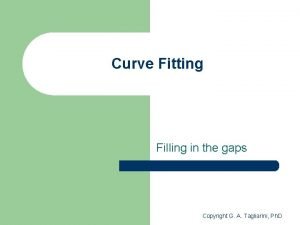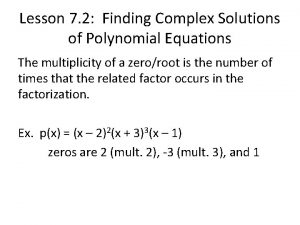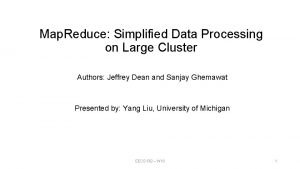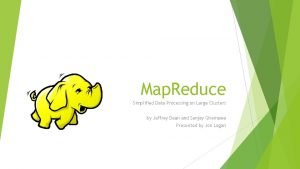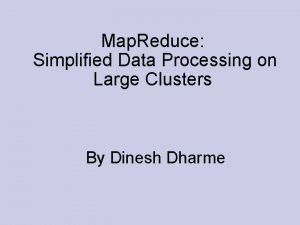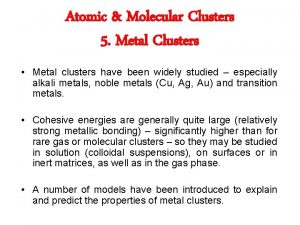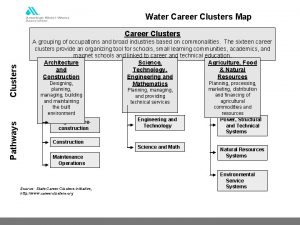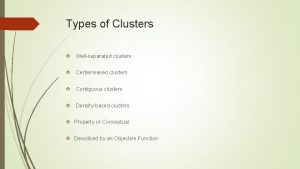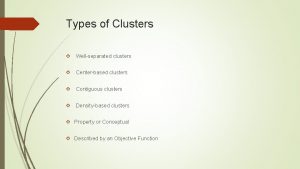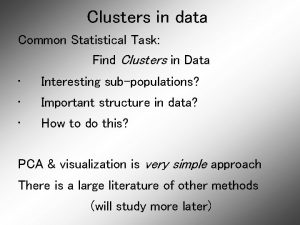Finding Islands Gaps and Clusters in Complex Data















- Slides: 15

Finding Islands, Gaps, and Clusters in Complex Data Ed Pollack Database Administrator Commerce. Hub

Agenda Finding Significant Patterns in Complex Data • • Quick Review: Structured/Inorganic Groupings Quick Review: Gaps & Islands in Simple Data Finding Data Clusters Answering Crazy Questions • • 2 TSQL Madness More Demos Performance Conclusion

Structured/Inorganic Groupings • We can partition data into segments based on static groupings. • Often dates or date parts, but can be other metrics. • Easy to visualize & understand. • Does not provide recursive/self-referencing feedback. • Boundaries can divide data into ill-conceived groupings. 3

Structured Groupings Demo

Basic Gaps/Islands Analysis • A self-joining query (of some sort) can locate missing data and build analysis based on it. • Useful for analyzing consistent sequences of data. • Can determine streaks, both positive or negative. • Many ways to perform analysis on numeric data. • Carefully consider data quality prior to analysis!!! 5

Basic Gaps/Islands Analysis Demo

Finding Data Clusters • Data can be organically grouped based on self-referential criteria. • Allows for related events to be identified. • Introduces internal proximity into analytics. • Data groups itself into clusters, regardless of external metrics. • Must determine grouping rules prior to analysis. 7

Finding Data Clusters Demo

Answering Crazy Questions • • Filters can control what data we include. Existence checks control cluster parameters. Join predicates determine what to group together. Examples of metrics: • Streaks, droughts, performance, unusual patterns, etc… • Dynamic SQL: Loop through dimensions to gather semiautomated insight. 9

Answering Crazy Questions Lots and Lots of Demos

Performance • Generally, these analytics rely on index/table scans. • Not intended for OLTP. Run on data that is: • Replicated, AG, ETL, OLAP, restored, etc • Helpful tools: • • 11 Covering indexes. Columnstore indexes. In-Memory OLTP. Automated analytics.

Gotchas • Fully understand data quality: • • NULLs Missing data Unexpected inputs/data values Duplicate data • The borders of a cluster within a multi-partitioned data set may require special treatment. • QA: thoroughly test all use cases! 12

Conclusion • Data can be organically grouped, regardless of complexity. • Results can be used to determine many useful metrics: • • Winning/losing streaks. Data clusters. Related events. Patterns or abnormalities within data • Be creative and find innovative solutions to seemingly impossible problems. 13

Questions? ? ?

Contact Info & Links for Ed Pollack ed 7@alum. rpi. edu @Edward. Pollack SQL Shack SQL Server Central Dynamic SQL: Applications, Performance, and Security SQL Saturday Albany (2016) Thank you!!!
 Gaps and islands
Gaps and islands Fills in gaps in data and fit data into curves
Fills in gaps in data and fit data into curves Finding complex solutions of polynomial equations
Finding complex solutions of polynomial equations Simple compound complex and compound-complex sentences quiz
Simple compound complex and compound-complex sentences quiz Ghon complex
Ghon complex Simple compound complex quiz
Simple compound complex quiz The electra complex
The electra complex Oedipus complex and electra complex
Oedipus complex and electra complex Sublimation in psychology
Sublimation in psychology Lisp map reduce
Lisp map reduce Guide to computer forensics and investigations 6th edition
Guide to computer forensics and investigations 6th edition Mapreduce simplified data processing on large clusters
Mapreduce simplified data processing on large clusters Mapreduce simplified data processing on large clusters
Mapreduce simplified data processing on large clusters Complex data types in data mining
Complex data types in data mining Mining complex types of data in data mining
Mining complex types of data in data mining Cs 412 introduction to data mining
Cs 412 introduction to data mining

